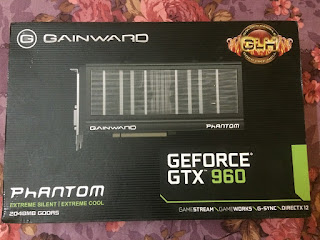At Computers and More we always strive to bring you something new in every way possible be it in terms of testing a product or simply just talking about a new technology that has hit the market. Recently we were reviewing a bunch of products that were great on performance but little heard of and today is no different!
A week back Gainward guys sent over their GTX 960 Phantom edition graphics card to my table & just like anyone else I had my own apprehensions regarding the product since Gainward is not something that you hear about daily but that was till I'd put the card to test, once the card powered on it was an absolute delight to play around with!
So enough of talking and coming back to the review, the below are the key specs of the Gainward GTX 960 Phantom Goes Like Hell (GLC) 2GB DDR5 graphics card.
Gainward has managed to overclock this card right out of the box & just like every other GTX 960 the card requires a single 6-pin PCIe power connector to draw power of upto 120W but we'll test the maximum power drawn later on. The card holds a little trick up its sleeve which I'll cover further down the review so stay put. Also the card is priced at around Rs 17000 which puts it at the near bottom of the price chart!
Packing and Closer Look
The Gainward GTX 960 Phantom comes in a black grill textured cardboard box with a clear photograph of the product right in the middle and the Gainward and GLH logo neatly perched at the top corners.
At the back apart from the usual blah blah about the GTX 960 & its Maxwell architecture we find the exclusive features of the Gainward Phantom enlisted at the right side. A nice diagram about its fans and cooling etc is quite informative and makes it easy for the buyer to understand this exclusive line of features.
Inside the box you will fins the card securely packed in a giant blister pack casing underneath which all the bells and whistles are kept. A common set of accessories include a twin molex to 6-pin PCIe power connection, VGA to DVI adapter and Gainwards driver install and quick start guide.
This latest offering from Gainward features the newest iteration of the Phantom cooler which not only gives the card its distinct look of a Star Wars gadgetry reminiscent but comes with a very interesting set of fans.
The top and bottom of the card are completely sealed off by the plastic shroud giving it the dimensions of 243 × 112 × 51 mm which is a bit too thick for tri SLI. On top you can see the 6-pin power connector.
At the back side we observe that their is no backplate which is a bit of a shame since that would've completed the entire sealed armor like look. Also the two of the four Samsung memory chips are visible on the PCB and the cooler infact is 1/5th longer than the PCB itself this directly translates to more air flow and hence better cooling.
For the I/O portion the card is equipped with twin DVI ports, a single DisplayPort and a HDMI port capable of 4K resolution. Did you notice that the fans are under the radiator and not over it unlike other cards?
Now for the fun part....the cooling fans are removable! Yes they are and can be easily slid out from their sockets once the thumb screw is loosened so its a completely tool-less mechanism!
Its a patent design & ensures that you can simply pull the fans out and clean them from dust and grit whenever needed. Simple yet effective solution isn't it!
Fans are a standard 80mm 12V PWM fan from Power Logic and these as Gainward claims keep the card 6°C cooler than its counterparts under heavy load at 6dB lesser noise levels.
Upon separating the cooler from the PCB we can now clearly see the two units in their bare form.
The third generation Phantom cooler consists of a thick radiator, removable fans and heatpipes. The fans pull the cold air from outside through the radiator fins and heatpipes to cool down the entire arrangement.
Four 8mm heatpipes summit at a cold plate that makes direct contact with the GPU rather than the heatpipes themselves. This is an unusual arrangement and the first of its kind amongst recent cards.
The PCB is quite small and quite barren with very few components since its a basic card with low power requirements. The nVidia GM206 GPU rests at the center surrounded by the various components.
Gainward uses a four phase power delivery system for the GTX 960 Phantom constituted by durable solid capacitors and power transistors RdsON. A dedicated heatsink is even provided to provide cooling since the card is factory overclocked.
The other side has two of the four Samsung GDDR5 memory chips that give the GTX 960 its total 2GB of VRAM. The chips are marked K4G41325FC-HC28 and are of 512MB each.
Testing and Benchmarks
The Gainward Phantom GTX 960 out of the box comes at 1279Mhz on the memory and 1342Mhz on the boost clock which is already higher than the reference GTX 960 available but that doesn't mean we cannot attempt an overclock on the card.Gainward is not popular for its overclocking potential hence their included utility named as the Gainward Expert Tool 2 isn't upto the mark for the same! It does provide basic functions like fan control etc but for adjusting the frequencies its a pain due to its petite pointers and no provision for manual frequency input not to mention its bland looks!
So we stuck with our favorite MSI Afterburnerand & managed 370Mhz increase on the memory and 105Mhz on the core to achieve a stable 1384Mhz on the core and 1985Mhz on the memory at default voltage settings. This is not a bad overclock at all and is nearly identical to what other GTX 960 models can achieve.
For testing the Gainward Phantom GTX 960 we had a test bench consisting of the following components:
CPU: Intel Core i7 5930K 3.5Ghz hexacore processor OC at 4.1Ghz
Motherboard: Gigabyte G1 Gaming X99-Gaming 5P
RAM: Kingston HyperX Predator 16GB DDR4 (4x4) 3000Mhz Memory Kit
Cooler: Corsair H100i GTX 240mm Liquid Cooler
Graphics Card: Gainward Phantom GLH GeForce GTX 960 2GB DDR5
Storage: Corsair Neutron GTX 480GB SSD
Power Supply: Corsair AX860i 860W 80+ Platinum
OS: Windows 8.1 Pro 64-bit
BIOS: F1
GPU Driver: NVIDIA ForceWare 355.60
For the benchmarks our concern is not to put the card to overwhelming tests and obtain stats that are utterly unplayable in real life but to get playable frame rate at the highest possible setting with regards to the card's potential.
AIDA64 Extreme Edition GPGPU
The AIDA64 GPGPU test not only calculates the read, write and copy speed of the graphics card and processor but is also very useful in observing the SHA-1 Hash and AES-256 score. These are indications of how well the GPU can handle number crunching or real life image or video rendering. Higher score shows a better card.The scores are good enough for a budget card & the overclocking sure has done wonders in contrast to the stock performance.
Unigine Heaven 4.0
A compilation of 26 beautiful scenes rendered and run via the raw GPU power of the system. It emulates any game of graphical work that you'll perform on the system scoring it on various parameter. We ran the test on Custom preset and settings at 1920x1080 resolution, quality to high and 4xAA tessellation.Unigine Valley 1.0
The new benchmark from the Unigine Heaven developers themselves uses a dynamic and demanding emulation of a lush green valley constituted by vast mountains amazes with its scale from a bird’s-eye view and is extremely detailed down to every leaf and flower petal. We ran the test on Custom preset and settings at 1920x1080 resolution, quality to high and 4xAA tessellation.3D Mark Fire Strike
Fire Strike by 3D Mark is a test suit that plays a cinematic scene to determine the FPS, GPU temperature and CPU temperature scaling everything via a cumulative score. It is a great tool to benchmark your GPU since the render is GPU dependent.The card works great at lower 720p resolution tests & produces respectable scores at 1080p resolutions but at 4K the limited 2GB memory and 128bit width comes into play choking the GTX 960 to quite a lot.
3D Mark 11 Professional Edition
Another variant of the Fire Strike by 3D Mark but more demanding on resources, used mainly for scoring the GPU performance.The same story is repeated over here and the card chokes at 4K and at higher resolutions indicating it to be a 'no-go card' for extreme performance at high resolutions.
Crysis 3
I can't start gaming benchmarks without running my all time favorites Crysis 3 but its a game that no system loves! The CryEngine 3 behind this scenic beauty can bring down any system to its knees and I mean any system. I set everything to Very High at 1920x1080 resolution with SMAA 2X and motion blur medium.Tomb Raider 2013
The reincarnation of Lara Croft in the spectacular Tomb Raider 2013 with stunning graphics and TressFX makes it a great game to benchmark with, especially on Nvidia cards and also to enjoy in the due course! Settings were at Ultimate with TressFX enabled on full HD resolution.Alien Isolation
Its a great game for people, like me, who love to hunt down Xenomorphs or aliens with guns blazing all over the place. The game is highly optimized for PC and supports DirectX 11 with Tessellation, real-time Direct Compute radiosity, and shadows making it an ideal game to benchmark with settings at Ultra.Batman Arkham Knight
Since the game is powered by Epic's Unreal Engine 3 and supports DX11 tessellation so playing this game on 1920x1080 resolution with all settings maxed out can be any modern system's 'worst nightmare'! While benchmarking all setting were set to normal with nVidia exclusive features disabled.Battlefield 4
Based on the DICE's Frostbite Engine 3 this game not only taxes a CPU and GPU both by reproducing lush details on the screen but also utilizes the DX11 and DX11.1 features coupled with 64-bit binaries! Settings were at Ultra with antialiasing deferred at 2x MSAA and ambient occlusion enabled.Far Cry 4
A bit poorly optimized game for the PC port adds up to its taxing nature on systems! Powered by the latest version of the Dunia 2 engine, Far Cry 4 takes advantage of DirectX 11 and is extremely resource heavy. Optimized for Nvidia GPUs this game can be taxing on AMD cards on higher settings. Settings at High on 1920x1080 resolution with Fur on, Godrays to Volumetric fog and ambient occlusion enable.Mad Max
Powered by the Havok engine you find yourself in the shoes of a man struggling for survival on a post apocalyptic earth. A beautiful game that we tested at everything cranked up to maximum on full HD resolution.Assassin's Creed Unity
A beautiful creation by Ubisoft that can be severely punishing on most of the GPUs since it has a lot of water texture to render and rich distant objects to reproduce on the screen. God rays were enabled at high and details were set at High. Anti-aliasing was at TXAA 2X along with ambient occlusion to HBAO+. Keep in mind that this game is optimized for Nvidia GPUs and not neutral.GTA V
I know you were missing this in the list, don't worry I've got your back. Rock Star Games made the PC port of this game so well optimized that by utilizing the CPU and GPU alike it produces scenes that can put any console to shame, to put it mildly. We tested the game at High settings at 2xMSAA, Grass, Reflection and Post FX at High. Anisotropic Filtering and reflections MSAA were off.Noise and Temperature
With ambient temperature at 29°C the Gainward Phantom GTX 960 puts up a good temperature reading at default fan settings. The fans are a bit noisy for my ear since we were using an open test bench but that's okay with many since you'll have it enclosed inside a chassis.
My Verdict
I've tested a lot of cards on and off this blog and that not only includes different models but also same models from different brands which have almost the same thing going on in way or the other on the same PCB but when it comes to the Gainward Phantom its a whole different story!The small tits and bits that Gainward has put into this product from the ground up has yielded a clear winner in the form of the Phantom GTX 960. Even if I don't talk about the ingenious cleaning mechanism in form of removable fans or the efficient cooling that follows it through then also the sheer performance of the card for this price point is unmatched!
But like every good thing the Phantom even has some short comings such as the Expert Tool II utility which is quite bland and a user's nightmare while playing around with frequencies. Absence of a backplate is something that anyone will miss considering its monolithic design style.
I recommend the Gainward Phantom GLH GTX 960 2GB DDR5 to anyone who is looking for a card with a solid performance, cool design and an edge to the entire bundle all coming in at a price point that'll easily fit in every budget gamer's pocket.
I give it 8/10

























































Vishvesh, how does this compare to similarly priced AMD offerings?
ReplyDeleteHello,
DeleteThe direct competition to the GTX 960 is the R9 380 which is marginally faster and better in terms of raw performance than the former. At 720p & 1080p in most of the games the results are identical but once you increase the resolutions or go for very high to ultra settings on games like Crysis 3, Batman Arkham Knight or GTA V the R9 380 will outperform the GTX 960 due to its higher bus width and this is applicable for both 2GB and 4GB variants of the same.
I have both cards with me so you can count on my words.
"I have both cards with me so you can count on my words."
ReplyDeleteI do not doubt that... it is just easier to understand product value, when a direct comparison is made. That's all. ;)
I appreciate your trust in me, really means a lot but had to mention that keeping in mind the fact that the R9 380 has not got enough coverage on the web especially by big review institutions.
DeleteTalking about direct comparison the R9 380 has a higher power consumption than the GTX 960 so when buying that make sure you have enough power to feed the unit.
Keep visiting.